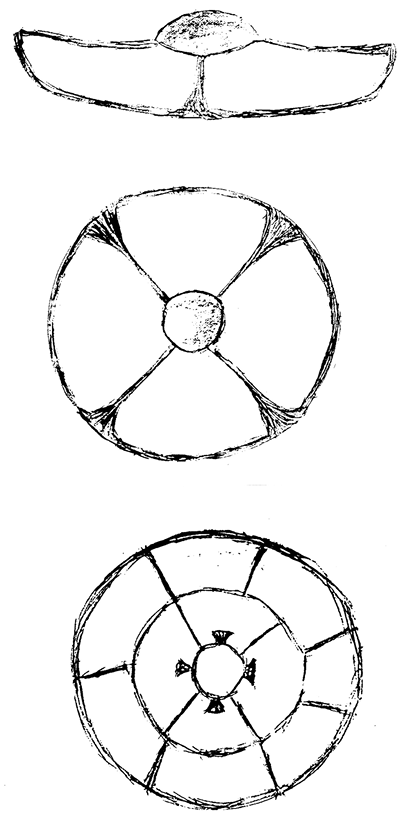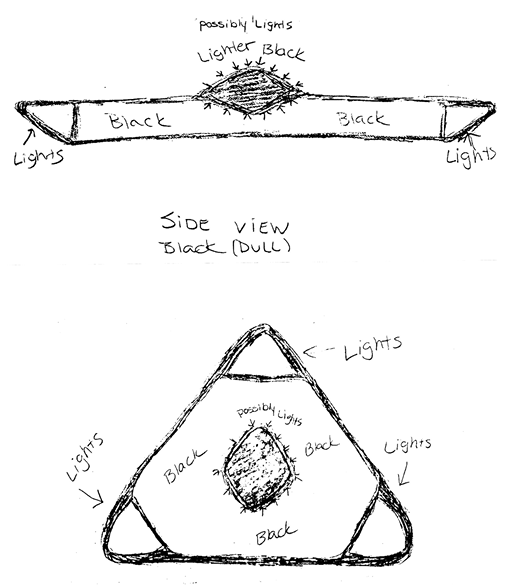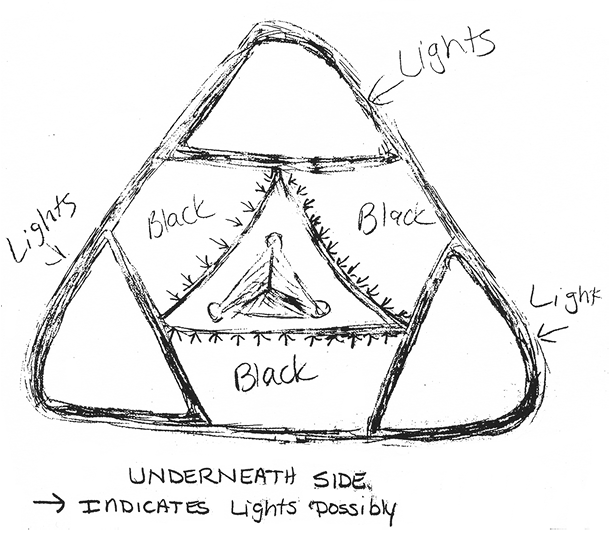Earth (35 page)
Authors: Timothy Good

McCandlish learned some pertinent information from Sorensen relating to aspects of the ARV's propulsion. Inside the craft was a central column, for example, containing a type of vacuum chamber:
“Brad maintained that inside this big vacuum chamber that's inside everything elseâinside the flywheel, inside the secondary coils of the Tesla coil, inside the crew compartmentâthere is mercury vapor. Mercury vapor will conduct electricity, but it produces all kinds of ionic effects. These little molecules of mercury become charged in unusual ways, and if you fire a tremendous amount of electricity through mercury vapor that's in a partial vacuum, there is something special, something unusual [that] happens in that process.”
22
It is pertinent to point out here that, in conversation with the gardener Leonard Mantle in 1969, some of the technological information imparted by “Iso Khan” chimes with Sorensen's description. For instance, Mantle learned that the propulsion system of the craft used by Khan's race included a cylindrical column that contained mercury (Chapter 12). And in Chapter
13 we learned that the “W56” aliens required mercury for many of their applications, including craft, the propulsion of which they revealed to several of their contacts as part of a technology transfer.
George Adamski was the first to publish details of a central column inside smaller spacecraft, describing how “a pillar about two feet thick extended downward from the very top of the dome to the center of the floor. Later I was told that this was the magnetic pole of the ship, by means of which they drew on Nature's forces for propulsion purposes, but they did not explain how this was done.” He did learn, however, that the top of the pole was positive while the bottom was negative. “But, when necessary,” his host explained, “these poles can be reversed,” and added that the central pillar served a double purpose, “as a powerful telescope, with one end pointing up through the dome to view the sky, and the other pointing down through the floor to inspect the land belowâ¦.”
23
Vandenberg and Edwards Air Force Bases
In 1986, Peter Biagio Tresca, an aerospace engineer, was joint director of Lawrence Engineering and Supply Inc., based in Burbank. Tresca's daughter Teresa, who worked for her father at the time, recalls seeing blueprints on her father's desk that depicted what looked like a type of flying saucer. “Apparently the government had made them,” she told me. “I wanted to take the blueprints and show them to my teacher at college, but they weren't allowed out of the office.
“My father used to take me to air shows, and in August or September 1988 he took me to a restricted show at Vandenberg. And I saw the demonstration of a flying saucerâlike the one on the blueprints. I was busy watching a display of jets when it suddenly came in from the left, came in front of us, and then took off again. I didn't hear it approaching.”
24
Her husband, British UFO researcher Philip Waterhouse, fills in further details:
“She said the craft approached from near some hangars and hovered silently at about ten feet, apart from a relatively high-pitched humming noise. Then after about five minutes the craft pitched up and shot off into the sky to the right of where they were standing. There were only about twenty people, including her father and herself, who were witness to this event.
“She said the craft was about twenty or twenty-five feet wide and
about ten feet high. What is interesting about her description is the fact that the bottom was bowed upwards, which is fairly uncommon. And the craft appeared all in one piece, though it seemed to be sectioned in a circular way, with a dome on top. It was silver-colored all over, apart from the [indented] parts, which could have been shadows.”
Teresa's sketches of the side, top, and bottom of the craft appear below:

“What is also interesting to me and what originally caught my attention
when she described her visit there,” Philip continued, “was the fact that before the flying saucer was viewed, she and her father and others were witness to other stealth aircraftâand one triangular craft.
“She said the triangular craft was completely silent without any discernable hummingâonly the [displaced] air traveling around it. The craft hovered at about nine feet, tipped forward and backward and turned around its axis, rose another ten feet at least, and then took off silently at great speed.
“She described the craft as being a dull black (not shiny) with a pitch-black smoky non-see-through dome on top. She also saw what she described as discernable undercarriage arms underneath, which were of a darker-colored black. The craft also had what appeared to be âlights' at each triangular cornerâalthough she didn't see any light as such. They were of the same smoky dull appearance as the domed canopy on top.”
25
[See sketches below.]


Toward the end of the following summer (1989), Teresa accompanied
her father to Edwards Air Force Base to attend another restricted air show. The same number of people was present. She saw more of the conventional stealth-type aircraft, and what appeared to be the same black triangle. The saucer-shaped craft did not make an appearance.
“What was the level of security?” I pressed her. “Did you need any special access?”
“My dad did,” she replied. “I would ask him questions, but he never really told me anythingâhe was really âhush-hush' about it all.”
“And it was just a relatively small number of people at these two air shows?”
“Yes. I would say about fifteen or soâmostly men. Apart from my father, there were other âbig-wigs' from Lawrence Engineering, such as Fletcher Seymour, Ray Barker, Ray and Mary Smithâ¦. Of course, there was also a lot of military there.”
“But weren't they concerned?” I asked, incredulously. “You were just with your father, and you were let in on it, so to speak?”
“I think my Dad was questioned about it because he was walked off.
They took him off somewhere and questioned him, because that was the last time that I was able to go to a show. And after that, it was like everything was hush-hush.”
26
Prior to marrying Philip, Teresa worked for five years as a sheriff for the Santa Clarita (California) Sheriff's Department. I find her testimony compelling, and it provides corroborative evidence for the observations reported by the previous witnesses.
Los Alamos
The demonstration of a much smaller craft was described for me by Gregory Molesworth, a former U.S. Army lieutenant colonel and platoon commander who served in Vietnam. In Washington, D.C., in February 1994, he told me that eighteen months previously, he had been working as a sound man for a British Broadcasting Corporation (BBC) documentary on the Strategic Defense Initiative (SDI). While filming at Los Alamos National Laboratory, he witnessed the demonstration of a four-foot-diameter disc, radio-controlled via a joystick in a metal-lined laboratory. As “foreign nationals,” British participants were not allowed inâand Molesworth himself was threatened if he tried to film anything.
California Bases
“I have been reading recently about all the alleged underground alien labs and facilities and took particular interest in a rumor purporting an underground base of this kind to be located in the Lancaster/Palmdale area near the Tehachapi Mountains,” begins a narrative from “Alex R.,” a woman who together with her friend Annemarie had a somewhat disturbing experience in the early 1980s.
Annemarie had purchased some undeveloped land in that area. She herself, however, had not yet seen it: her husband Ken had bought the property and confirmed that it was in an ideal location, then deeded it over to her after they divorced, giving her a rough map with some landmarks to assist her in locating it.
“We drove the nearly two hours to Lancaster/Palmdale and began our search. The map was not much help, however, because it had been made when the area was still undeveloped. And most of the natural landmarks
were goneâremoved to make room for houses. Every time we found what looked like a road which would take us somewhere, it turned into a dead-end. The area we were in was now full of cul-de-sacs for the housing development that would soon be built on it. After about two and a half hours of driving, we stopped for a cool drink.
“We got back on the main highway and decided to look for dirt roads in the hope that the land was still undeveloped and that we had missed itâ¦. At last, a broad, well-kept dirt road appeared. At first we thought it might be the entrance to someone's farm or ranch but, since there wasn't a mailbox, we decided to proceed. After about half a mile, something odd happened: the dirt road became a wide, beautifully paved asphalt road, with a single white dividing line. We were astounded at this but were glad, as the dirt road was taking its toll on Annemarie's car.
“We had driven about two miles when, up ahead, we saw what looked like a dust storm coming out of the mountains. Annemarie slowed down, and we watched. It was not a storm but a vehicle, a car, coming toward us at full speed. âLet's get out of here!' I said. âI don't think that would be a good idea,' said Annemarie. She came to a complete stop, right in the middle of the road. âAre you crazy?' I said. âStay calm and let me do the talking,' she said.
“The car, a drab olive green late-model sedan, was, by now, up on the road, still driving full speed. They were heading directly for us. I was afraid that they would not stop in time and would hit us. The car stopped, brakes screeching, within inches of us, and two men got out. A third man remained in the car. They were young men, in their mid-thirties, dressed in pale blue coveralls (no name plates or insignias) and baseball caps. One had sandy-colored hair, the other was white-blond. The third man was in the front seat of the car, talking on the radio-microphone. All wore wrap-around sunglasses. Somehow, I knew that we might be in terrible trouble and that we were somewhere we didn't belong.
“The sandy-haired man came up to the driver's side of the car; the blond one was on my side, the passenger side. He kept his right hand in his pocket at all times. I wondered if he was carrying a gun. âGood afternoon, ladies!' said sandy-hair. âWhere are you going?' Annemarie showed him the map. âWe're trying to find my property,' she said. âCan you help us?'
“He studied the map. âYou haven't been here for a while, have you?' he said. â
All of these places on the map have been removed or destroyed.' He looked at the map again. âThis place looks like it might be on the other side of town. Why don't you look there?' He was extremely polite, smiling all the while he spoke, yet he terrified me and Annemarie. The blond man never spoke, nor did he smile or look at me. The third man remained on the radio. âWe'll be happy to escort you ladies back to the main road.'
“Though it sounded like a polite suggestion, it was actually an order to leave now. Annemarie said nothing, merely backed up slowly and drove back, still slowly, to our place of entrance into this âforbidden' area. The men and their car stayed close behind us and followed us for several miles. Annemarie and I did not speak during this time. I think we were too scared. Then, instead of going back to the main part of the city, she took the next freeway on-ramp and headed back home. I noticed that she kept looking in her rear-view mirror. âSomeone is following us,' she said.
